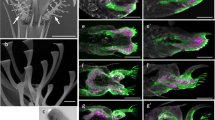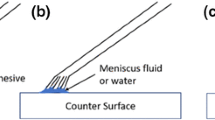Abstract
The amazing climbing ability of geckos has attracted the interest of philosophers and scientists alike for centuries1,2,3. However, only in the past few years2,3 has progress been made in understanding the mechanism behind this ability, which relies on submicrometre keratin hairs covering the soles of geckos. Each hair produces a miniscule force ≈10−7 N (due to van der Waals and/or capillary interactions) but millions of hairs acting together create a formidable adhesion of ≈10 N cm−2: sufficient to keep geckos firmly on their feet, even when upside down on a glass ceiling. It is very tempting3 to create a new type of adhesive by mimicking the gecko mechanism. Here we report on a prototype of such 'gecko tape' made by microfabrication of dense arrays of flexible plastic pillars, the geometry of which is optimized to ensure their collective adhesion. Our approach shows a way to manufacture self-cleaning, re-attachable dry adhesives, although problems related to their durability and mass production are yet to be resolved.




Similar content being viewed by others
References
Aristotle Historia Animalium Book IX (trans. Thompson, D.A.W.) (Clarendon, Oxford, 1918); http://classics.mit.edu/Aristotle/history_anim.html.
Autumn, K. et al. Adhesive force of a single gecko foot-hair. Nature 405, 681–685 ( 2000).
Autumn, K. et al. Evidence for van der Waals adhesion in gecko setae. Proc. Natl Acad. Sci. USA 99, 12252–12256 ( 2002).
Cappella, B. & Dietler, G. Force-distance curves by atomic force microscope. Surf. Sci. Rep. 34, 1–104 ( 1999).
Yamamoto, K., Tanuma, C. & Gemma, N. Competition between electrostatic and capillary forces acting on a single particle. Jpn J. Appl. Phys. 34, 4176–4184 ( 1995).
Stork, N.E. Experimental analysis of adhesion of Chrysolina polita (Chrysomelidae: Coleoptera) on a variety of surfaces. J. Exp. Biol. 88, 91–107 ( 1980).
Schäffer, E., Thurn-Albrecht, T., Russell, T.P. & Steiner, U. Electrically induced structure formation and pattern transfer. Nature 403, 874–877 ( 2000).
Sekine, M. Dielectric film etching in semiconductor device manufacturing: Development of SiO2 etching and the next generation plasma reactor. Appl. Surf. Sci. 192, 270–298 ( 2002).
Acknowledgements
This work was supported by EPSRC (Engineering and Physical Sciences Research Council) UK. S.V.D., A.A.Z. and S.Y.S. also acknowledge the financial support of the Russian Academy of Sciences.
Author information
Authors and Affiliations
Corresponding author
Ethics declarations
Competing interests
The authors declare no competing financial interests.
Rights and permissions
About this article
Cite this article
Geim, A., Dubonos, S., Grigorieva, I. et al. Microfabricated adhesive mimicking gecko foot-hair. Nature Mater 2, 461–463 (2003). https://doi.org/10.1038/nmat917
Received:
Accepted:
Published:
Issue Date:
DOI: https://doi.org/10.1038/nmat917
- Springer Nature Limited
This article is cited by
-
Nature-inspired micropatterns
Nature Reviews Methods Primers (2023)
-
Beyond the Classical Cauchy–Born Rule
Archive for Rational Mechanics and Analysis (2023)
-
Core–shell dry adhesives for rough surfaces via electrically responsive self-growing strategy
Nature Communications (2022)
-
Contact Electrification and Adhesion Between Carbon Nanotube and Graphene on Metal Surfaces: Insights from First-principles Study
Journal of Bionic Engineering (2022)
-
Learning from biological attachment devices: applications of bioinspired reversible adhesive methods in robotics
Frontiers of Mechanical Engineering (2022)





